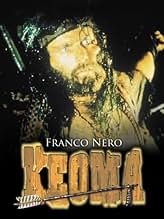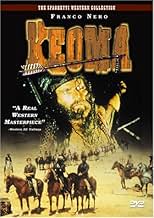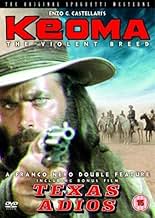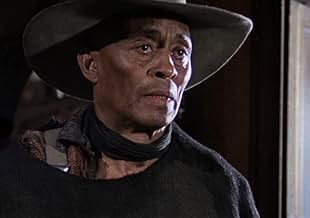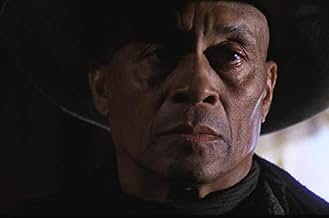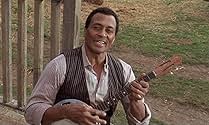IMDb RATING
7.0/10
6.6K
YOUR RATING
An ex-Union gunfighter attempts to protect his plague-ridden hometown from being overridden by his racist half-brothers and a Confederate tyrant.An ex-Union gunfighter attempts to protect his plague-ridden hometown from being overridden by his racist half-brothers and a Confederate tyrant.An ex-Union gunfighter attempts to protect his plague-ridden hometown from being overridden by his racist half-brothers and a Confederate tyrant.
Joshua Sinclair
- Sam Shannon
- (as John Loffredo)
Donald O'Brien
- Caldwell
- (as Donald O'Brian)
Leonardo Scavino
- Doctor
- (as Leon Lenoir)
Antonio Basile
- Caldwell's Henchman
- (uncredited)
Giovanni Bonadonna
- Caldwell's Henchman
- (uncredited)
Armando Bottin
- Caldwell's Henchman
- (uncredited)
Aldo Canti
- Wagon Fugitive
- (uncredited)
- …
Felice Ceciarelli
- Caldwell's Henchman
- (uncredited)
Featured reviews
After the American Civil War, the half-breed Keoma (Franco Nero) returns to his homeland and rescues a beautiful pregnant woman accused of having plague, Lisa (Olga Karlatos), from a gang leaded by the landlord Caldwell (Donald O'Brian). Later he meets his former slave servant and friend George (Woody Strode), now a drunk free man, and his father, William Shannon (William Berger), and he is informed that the town is under siege of Caldwell's men, without supplies of medicine or food and justice, with the dweller dying of plague and starvation and sick people is being isolated in an old mine. Further, his three dangerous half-brothers have joined Caldwell's force. Keoma decides to help Lisa and the dwellers to retrieve their freedom and dignity, and he finds how despicable the inhabitants are.
The unknown western "Keoma" was a great surprise for me. Although predictable, the story is great, disclosing the relationship of Keoma with his brothers and father through his recollections from his childhood, and does not have a happy commercial end. Franco Nero is amazing in the role of a lonely half-Indian with a great sense of justice and freedom, love and loyalty to his father and regret and resentment to his half-brothers. The direction and cinematography are excellent, with a fantastic choreography of the fights, set decoration and costumes: in the dusty, windy and dirty city, the men's clothes (and themselves) are very dirty, and not like in most of Hollywood movies, where the cowboys wear very clean clothes. There is a particular scene that I believe is unique in the cinema, when Keoma promises four bullets for four hit men, and while bending his four fingers, we see each of his targets. The annoying soundtrack, although having the good intention of creating a narrative of the feelings of the characters, is the only negative aspect in this movie. My vote is seven.
Title (Brazil): "Keoma"
The unknown western "Keoma" was a great surprise for me. Although predictable, the story is great, disclosing the relationship of Keoma with his brothers and father through his recollections from his childhood, and does not have a happy commercial end. Franco Nero is amazing in the role of a lonely half-Indian with a great sense of justice and freedom, love and loyalty to his father and regret and resentment to his half-brothers. The direction and cinematography are excellent, with a fantastic choreography of the fights, set decoration and costumes: in the dusty, windy and dirty city, the men's clothes (and themselves) are very dirty, and not like in most of Hollywood movies, where the cowboys wear very clean clothes. There is a particular scene that I believe is unique in the cinema, when Keoma promises four bullets for four hit men, and while bending his four fingers, we see each of his targets. The annoying soundtrack, although having the good intention of creating a narrative of the feelings of the characters, is the only negative aspect in this movie. My vote is seven.
Title (Brazil): "Keoma"
Castellari's Keoma was part of the late 1970's second wave of spaghetti westerns. It is typically considered one of the better entries in the genre, some even rate it as a classic alongside Leone's masterpieces. However, while it has clearly been attempted to make the film look stylish and sophisticated, and at a casual glance it does look pretty well made, a more in depth look shows that it falls quite a long way off the mark.
Basically, it's clear that what Castellari has is a bunch of director's tricks up his sleeve - slow motion, unconventional camera angles, subtle merges into flashbacks and so on - all of them thieved from the work of other filmmakers. That in itself is no bad thing - after all Tarantino has made a career out of doing the same - but the difference is that Castellari clearly has no idea how and when to use these techniques. He simply throws them in at every opportunity, so that they actually stick out rather than enhance the film. The most obvious example is the Sam Peckinpah style slow motion deaths after someone is shot. In Peckinpah's films it was used skilfully to highlight the brutality of certain killings here and there throughout the movie. In Keoma it is used more or less every time someone is shot - about forty or fifty altogether - totally losing any impact it might have had.
Add to this that Keoma is a completely boring spaghetti western character - basically just a hippy with a colt - and not one of Franco Nero's better performances. The dialogue is terrible. The plot is text book spaghetti western back-for-revenge. This movie doesn't really have a lot going for it.
And then there is the music, famous itself among spaghetti western fans for being almost unlistenably bad, which seems to sum up the feeling of the entire film. Quite a nice melody, but either sung in a piercing shriek by the female vocalist or an unnerving growl by the male vocalist.
In short Keoma is a perfect example of style over substance - it's all dazzling flair in an attempt to cover up a pretty poor film. Viewers should stick to the real classic spaghettis like Sergio Leone and Sergio Corbucci's work.
Basically, it's clear that what Castellari has is a bunch of director's tricks up his sleeve - slow motion, unconventional camera angles, subtle merges into flashbacks and so on - all of them thieved from the work of other filmmakers. That in itself is no bad thing - after all Tarantino has made a career out of doing the same - but the difference is that Castellari clearly has no idea how and when to use these techniques. He simply throws them in at every opportunity, so that they actually stick out rather than enhance the film. The most obvious example is the Sam Peckinpah style slow motion deaths after someone is shot. In Peckinpah's films it was used skilfully to highlight the brutality of certain killings here and there throughout the movie. In Keoma it is used more or less every time someone is shot - about forty or fifty altogether - totally losing any impact it might have had.
Add to this that Keoma is a completely boring spaghetti western character - basically just a hippy with a colt - and not one of Franco Nero's better performances. The dialogue is terrible. The plot is text book spaghetti western back-for-revenge. This movie doesn't really have a lot going for it.
And then there is the music, famous itself among spaghetti western fans for being almost unlistenably bad, which seems to sum up the feeling of the entire film. Quite a nice melody, but either sung in a piercing shriek by the female vocalist or an unnerving growl by the male vocalist.
In short Keoma is a perfect example of style over substance - it's all dazzling flair in an attempt to cover up a pretty poor film. Viewers should stick to the real classic spaghettis like Sergio Leone and Sergio Corbucci's work.
A mestizo ex-soldier named Keoma (Franco Nero's long hair is a wig) helps a pregnant woman (Olga Karlatos) from cutthroats. Keoma (the word/name Keoma means freedom) returns to a small town after the Civil War . The ghastly village is ruled by violent outlaw gangs (led by Donald O'Brien), along with Keoma's three brother . Half-breed Keoma is helped by an alcoholic old man (Woody Strode) and his adoptive father (William Berger). The bandits leader prohibits the inhabitants leave from damned little town besieged by pest .
This twilight spaghetti Western packs a decrepit aesthetic, racist denounce and innovating scenarios set in Elios studios by designer production Carlo Simi, Sergio Leone's regular. There is full of action in the movie, guaranteeing fist-play, stunts and shootouts every few minutes and in Sam Peckinpah style. Franco Nero is cool, he bears a remarkable physical resemblance to JesusChrist , he helps a hapless pregnant and is crucified in Christian symbolic sequence. Interesting and thought-provoking screenplay by Luigi Montefiori or George Eastman who starred numerous Westerns. The plot of the film was mostly improvised at the same time the film was made, but director Enzo G. Castellari didn't appeal the original story. Because of problems with Schedule, the script was written for next day every evening, after filming at the day. Usual Spaghetti western secondaries appear, such as: William Berger, Ken Wood, Robert Dell'Acqua and Ricardo Pizzuti of the Terence Hil and Spencer films. Sensitive, perceptible musical score by Guido and Maurizio De Angelis with emotive atmosphere nearly the songs performed by Bob Dylan and Leonard Cohen. The picture was well produced by Manolo Bolognini, usual producer of Italian Westerns, such as: ¨Django¨, ¨Goodbye Texas¨ , ¨Boot Hill¨ , ¨Gunman of Ave Maria¨ and ¨California¨. Director Enzo G. Castellari has stated that out of all the films he has directed, Keoma this is his personal favorite . Followed by a sequel titled 'Jonathan of the bears' (1994) again with Franco Nero and director Enzo G. Castellari, being shot in Russia and including notable reminiscences with 'Dances with wolves', but the film failed at box office . Keoma was the 'swang song 'of Spaghetti because made not much after and resulted to be the 'coup of grace' of Italian Western.
This twilight spaghetti Western packs a decrepit aesthetic, racist denounce and innovating scenarios set in Elios studios by designer production Carlo Simi, Sergio Leone's regular. There is full of action in the movie, guaranteeing fist-play, stunts and shootouts every few minutes and in Sam Peckinpah style. Franco Nero is cool, he bears a remarkable physical resemblance to JesusChrist , he helps a hapless pregnant and is crucified in Christian symbolic sequence. Interesting and thought-provoking screenplay by Luigi Montefiori or George Eastman who starred numerous Westerns. The plot of the film was mostly improvised at the same time the film was made, but director Enzo G. Castellari didn't appeal the original story. Because of problems with Schedule, the script was written for next day every evening, after filming at the day. Usual Spaghetti western secondaries appear, such as: William Berger, Ken Wood, Robert Dell'Acqua and Ricardo Pizzuti of the Terence Hil and Spencer films. Sensitive, perceptible musical score by Guido and Maurizio De Angelis with emotive atmosphere nearly the songs performed by Bob Dylan and Leonard Cohen. The picture was well produced by Manolo Bolognini, usual producer of Italian Westerns, such as: ¨Django¨, ¨Goodbye Texas¨ , ¨Boot Hill¨ , ¨Gunman of Ave Maria¨ and ¨California¨. Director Enzo G. Castellari has stated that out of all the films he has directed, Keoma this is his personal favorite . Followed by a sequel titled 'Jonathan of the bears' (1994) again with Franco Nero and director Enzo G. Castellari, being shot in Russia and including notable reminiscences with 'Dances with wolves', but the film failed at box office . Keoma was the 'swang song 'of Spaghetti because made not much after and resulted to be the 'coup of grace' of Italian Western.
Though to be clear I wouldn't go as far as to call it "the best". Something the people involved are quick to point out or to. This is really good and you have a very charismatic (and hairy chested) Franco Nero starring. You also have supernatural elements, that may not be fully explained (not even by all the extras on the disc).
And you have old school shooutous, where bad guys seem to only need one bullet to bite the dust (literally), whereas good people have to be shot quite a few times mostly. So yes there are things that may seem or feel dated, but the overall sense is quite great. Not to mention the performances. Really telling and really inspired overall.
And you have old school shooutous, where bad guys seem to only need one bullet to bite the dust (literally), whereas good people have to be shot quite a few times mostly. So yes there are things that may seem or feel dated, but the overall sense is quite great. Not to mention the performances. Really telling and really inspired overall.
A half-breed Indian Keoma returns back to his hometown after fighting in the Civil War, and finds his town is being run by an ex-Confederate soldier Caldwell and his outlaws. He holds power over the town by letting the plague infect the inhabitants, and since he won't let any sort of treatment be transported in. He sets up a community for those infected, and this where Keoma rescues a pregnant woman on her way there and returns her back to town. His three half-brothers have joined Caldwell, and I don't think that highly of their brother's return. But loyalty to their father, they won't kill him. His father William Shannon and former family servant/only friend George eventually join Keoma to break the strangle hold Caldwell possess.
Whoa! How good? Real good. Director Enzo G. Castellari's grand looking and interesting spaghetti western comes across as a powerful and beautifully constructed Greek tragedy with a cynical and almost psychological edge bound to it. There's a bit everything chucked into this passionate and intelligent exercise. Breathing high on mood and atmosphere, photographer Aiace Parolin exquisitely frames the mercilessly brooding locations and Castellari's stylishly first-rate direction keeps the film sombre with a brutally unsparing and dirt-laced tone in its dramatic images and context. Good use of abstract lighting and composition, he knows how to keep the viewer at bay with slam-bang set pieces towards the end and a downbeat undercurrent. Inventive framing and exposition also shows the quality of his direction. The glorious slow-motion shootouts and editing technique (ala Sam Peckinpah) are dazzling and how about the constant jumping or leaping in the air. Was there a hidden trampoline on set?! Everything about it held a nice rhythm to it and you just get swept along. Even the flashback sequences are positioned in the story accordingly and in a fulfilling style. The lyrical story is full of symbolic and thematic issues (freedom being the main focal point) that do pack a punch, but also showing a vulnerable side. This gave it a real singular vibe to set it apart from the crowd. Hell, I didn't mind the uncanny and soaring ballad soundtrack too. The way it actually interlocked with the film's sequences, I thought it gave the film some soul and a backbone (well other than always charismatically reliable Nero). A rugged Franco Nero was outstanding. Both mentally and psychically in his scrappy determination and seldom figure Keoma. The impressively committed Woody Strode was excellent. William Berger brought class, and Olga Karlatos decently balanced out an innocent side that really was moving. Donald O'Brien nails it down in a starch turn as the villainous Caldwell.
Whoa! How good? Real good. Director Enzo G. Castellari's grand looking and interesting spaghetti western comes across as a powerful and beautifully constructed Greek tragedy with a cynical and almost psychological edge bound to it. There's a bit everything chucked into this passionate and intelligent exercise. Breathing high on mood and atmosphere, photographer Aiace Parolin exquisitely frames the mercilessly brooding locations and Castellari's stylishly first-rate direction keeps the film sombre with a brutally unsparing and dirt-laced tone in its dramatic images and context. Good use of abstract lighting and composition, he knows how to keep the viewer at bay with slam-bang set pieces towards the end and a downbeat undercurrent. Inventive framing and exposition also shows the quality of his direction. The glorious slow-motion shootouts and editing technique (ala Sam Peckinpah) are dazzling and how about the constant jumping or leaping in the air. Was there a hidden trampoline on set?! Everything about it held a nice rhythm to it and you just get swept along. Even the flashback sequences are positioned in the story accordingly and in a fulfilling style. The lyrical story is full of symbolic and thematic issues (freedom being the main focal point) that do pack a punch, but also showing a vulnerable side. This gave it a real singular vibe to set it apart from the crowd. Hell, I didn't mind the uncanny and soaring ballad soundtrack too. The way it actually interlocked with the film's sequences, I thought it gave the film some soul and a backbone (well other than always charismatically reliable Nero). A rugged Franco Nero was outstanding. Both mentally and psychically in his scrappy determination and seldom figure Keoma. The impressively committed Woody Strode was excellent. William Berger brought class, and Olga Karlatos decently balanced out an innocent side that really was moving. Donald O'Brien nails it down in a starch turn as the villainous Caldwell.
Did you know
- TriviaThe story line of the film was mostly improvised at the same time as the film was made. The original story treatment was written by Luigi Montefiori (aka George Eastman) and turned into a script by Mino Roli and Nico Ducci, but director Enzo G. Castellari didn't like what had been written by the latter two. Because of problems with the schedule, Castellari and actor Joshua Sinclair wrote the script for the next day every evening after filming of the day. Castellari was also open to suggestions from the cast and crew - Franco Nero has confirmed that he wrote some of his own dialogue.
- GoofsAt 7:08 riders on horseback in pursuit of two men running on foot fire their pistols. Both men on foot react as if hit by the first shot.
- Alternate versionsGerman version was cut for violence and pacing reasons by 8 minutes to secure a "not under 16" rating. Despite that, it still got put on the index list by the BPjM which means various sales and advertising restrictions. Fortunately in 2003, the movie was removed from the index list and the FSK granted the uncut version a "not under 16" rating.
- ConnectionsFeatured in L'Oeil du cyclone: Westernissimo (1995)
- SoundtracksKeoma
(uncredited)
Music by Guido De Angelis & Maurizio De Angelis
Lyrics by Susan Duncan Smith and Cesare De Natale
Performed by Sibyl Mostert and Cesare De Natale
- How long is Keoma?Powered by Alexa
Details
Contribute to this page
Suggest an edit or add missing content


